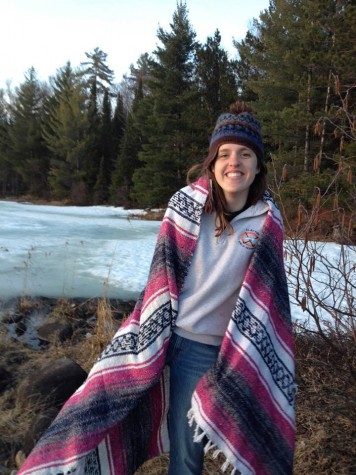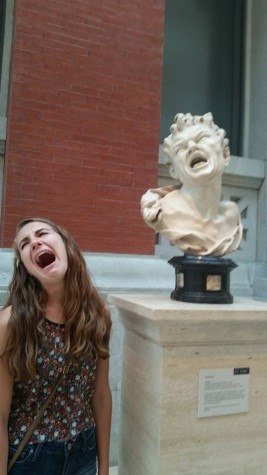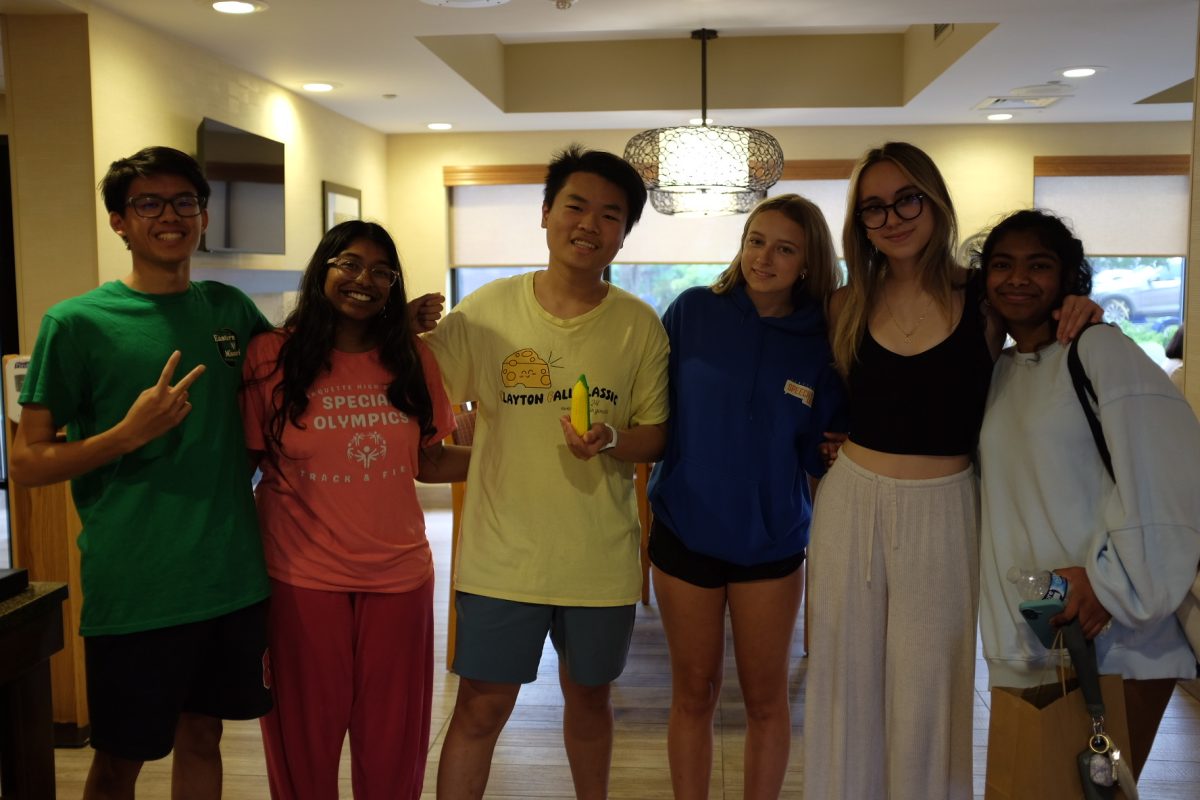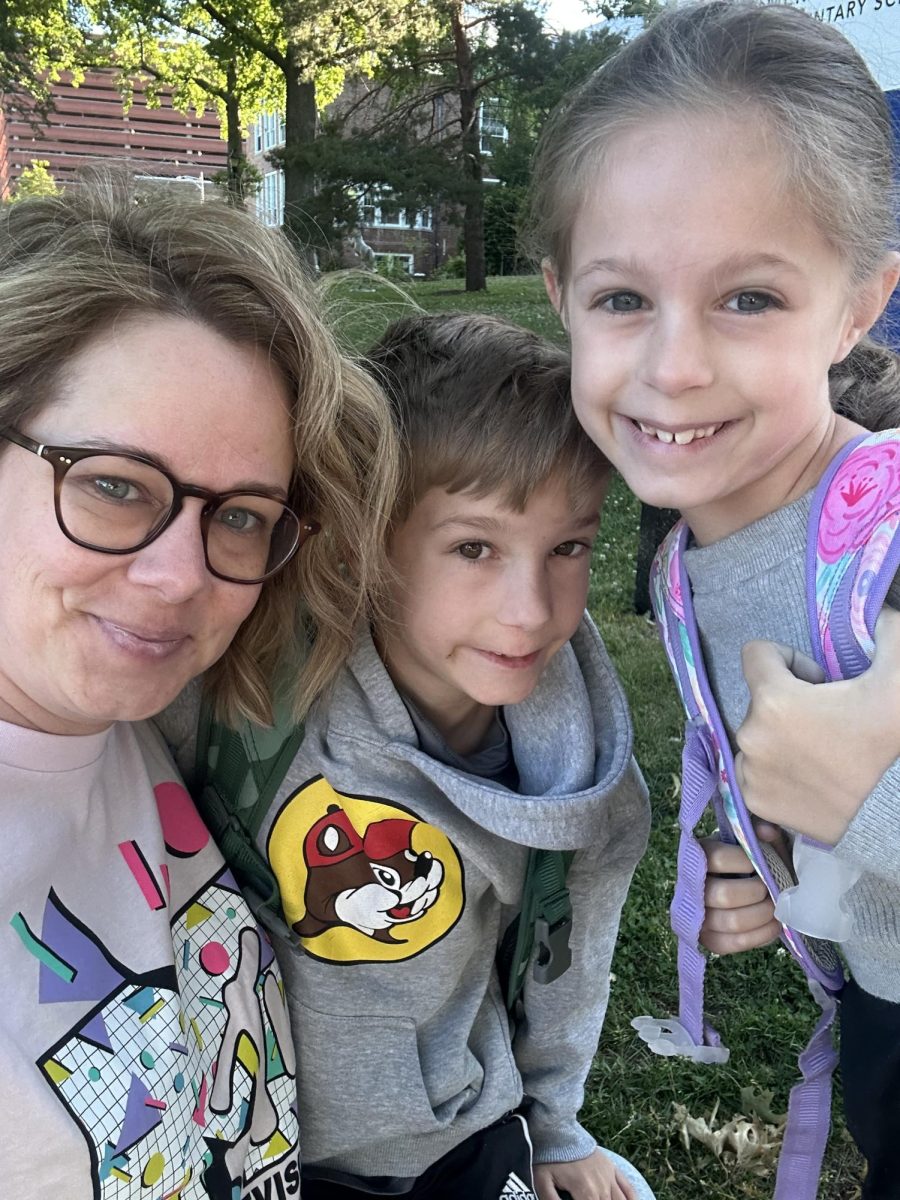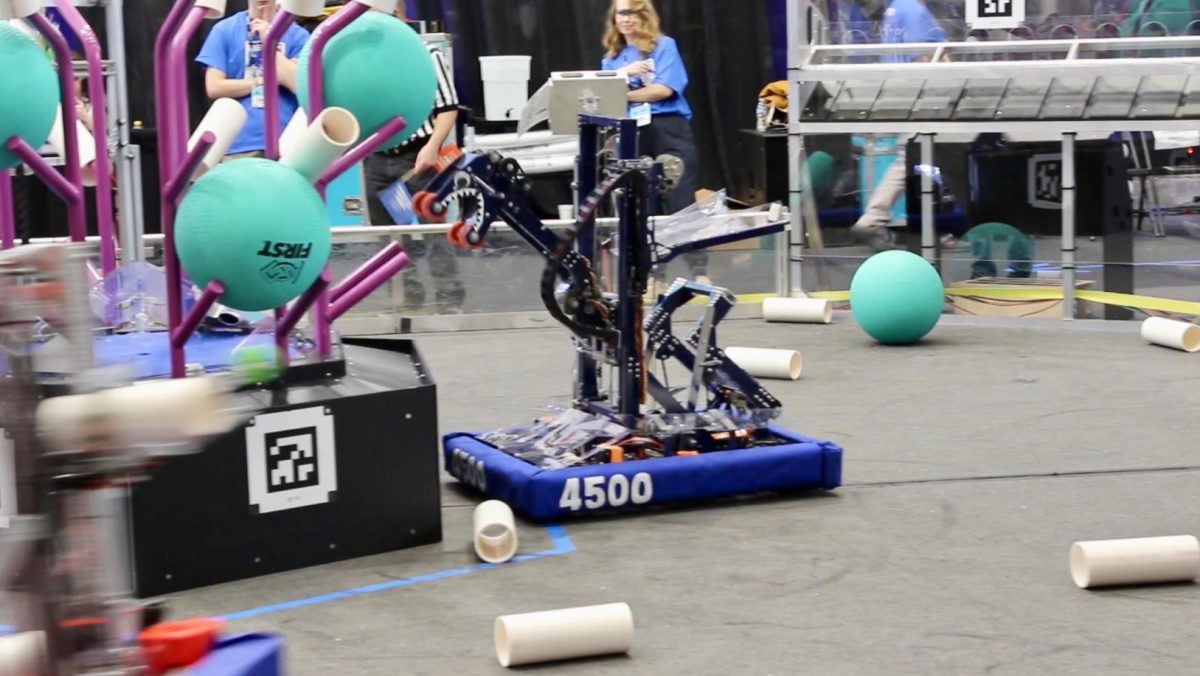Growing Problems
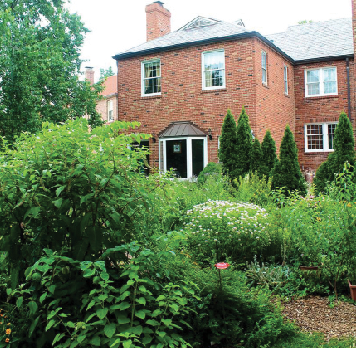
Mrs. Pang’s back yard during the summer.
March 23, 2015
I. Introduction
“This property here has monkey grass, which is from Japan. These are boxwoods, from Korea. That’s turf grass from England. This plant is lamb’s ear, from the Middle East.”
Susan Pang, local environmental activist, said this while walking down her Clayton residential street: more specifically, Lake Forest, one of the more affluent subdivisions within the district.
Drive through Lake Forest and after a while all of the front yards seamlessly meld into one: a sprawling lawn of manicured green grass, stone steps lined with twisted ivy and carefully pruned hedges bordering the entire property.
Lake Forest is no outlier. Examine any neighborhood in middle-class America and the same trend emerges: green lawn, crawling ivy, ornamental bush.
In fact, it is Pang’s yard that stands out as the oddity within a sea of foreign intruders. Her front lawn does not have one blade of turf grass. Instead, stepping stones weave amidst a multitude of plants all found naturally within the Midwest.
They all may share a common origin, but native plants exist in endless variation. Sprouting up from every corner of this Clayton yard lies a plethora of species that seem more uncommon than the foreign ornamentals suffusing America’s gardens. Pang’s yard includes plants unheard of by most people: New Jersey tea, prairie dropseed, clump grass and primrose.
In the midst of winter, Pang’s yard largely consists of brown tones, and to an untrained eye it might look as though the property suffered from lack of attention.
“A lot of people would look at my yard and think, ‘Oh my God what has she got going there, it’s like a jungle!’” Pang said, “But when I see my property I see that I don’t use a sprinkler system, I don’t use any chemicals at all and I have more flowers than anybody in this neighborhood.”
If neighbors think Pangs front yard is a jungle, then they’re in for a real shock when they head to the back.
Nearly all five senses come alive when walking through Pang’s backyard. The sounds of birds chirping pulses out from large pine trees bordering the property, and the air smells more like a forest than a residential back yard.
The ground, wet from a recent rain, hosts a myriad of species: black eyed susans, wintering coral berry, sedges, marsh milkweed and queen of the prairie.
On sweltering summer afternoons when most homeowners steer clear of their front lawns, Pang’s property serves as an oasis. She estimates that her backyard is 20 degrees cooler in the height of the summer.
“When people just have sprawling turf grass with nothing else you feel like you would die going into their yard,” Pang said, “I see that people don’t use their yards. My yard is very usable. It is very pleasant to be out here.”
As she walks amidst palm sedges and pokeweed, Pang points out a small bird with a long stripe on its head and a white patch on its throat.
“There’s a white throated sparrow! And those are birds that are in heavy decline. Every year I just say, ‘Please come back!’” Pang said.
Pang is committed to leaving much of her backyard untouched. She rarely rakes and never entirely clears fallen sticks, which can be valuable habitat for many insects.
“Many moths, butterflies and praying pantists leave their eggs on sticks,” she said. “When we disregard everything and throw it away, when we don’t leave any space in our yard for nature, that’s why there isn’t any.”
Pang, the Director of Environmental Affairs at the Wildlife Bird Rehab Center, has not always exuded such astounding passion concerning native species. Her interest began in 2010, after becoming a certified Master Gardener by the Botanical Gardens. In order to complete her mandatory volunteer hours Pang began working with Litzsinger Road Ecology Center, a 30 acre educational site in Ladue that focuses on prairie restoration and native planting. It was at Litzinger that Pang received her first native plant.
“I got my first native plants, and I just became enthralled,” Pang said. “I was noticing life and all kinds of things going on with my native plants.”
From there Pang began examining her own yard. Initially, her lawn was like that of any Clayton resident: predominantly turf grass dotted with 16 chinese yews, a common non-native hedge plant.
“I started taking out more of my turf grass. A little bit at a time – five feet here, five feet there, one patch here, one patch there.”
Currently Pang has only a few square feet of turf grass in her backyard.
Pang’s yard has value far beyond its aesthetic appeal. The great contrast between her explosion of natural character and the identical estates of middle-class America demonstrates a growing problem for the health of local ecosystems. Pang is doing her best to change the direction of the American landscape.
II. A Clayton Yard
Many residents of Clayton hire landscapers. They entrust their property to people who have a knack for design and presentation. Unfortunately, according to Pang, those landscapers rarely have a knack for creating an ecologically friendly space.
“A lot of people do what the landscape company recommends, and the landscape company has only about 20 plants that they carry,” Pang said.
These twenty species are genetic clones of one another, non-native and often unfit for the climate of St. Louis. The moment they are planted, homeowners begin a hard-fought battle to keep their front yard alive. When temperatures reach extreme highs or lows, these non-natives typically do not fare well.
“During the drought of 2012 I saw dead plants all over the place,” Pang said. “I saw dead azaleas, I saw dead hydrangeas, they were all dried up.”
In contrast, Pang never waters her own yard. Native species thrive in their local climate, meaning they can survive intense droughts and even sub zero temperatures. Pang equipped her back yard with several rain gardens and rain barrels. Rain gardens are planted with native plants that thrive under boggy and wet conditions. When heavy rains occur these gardens receive a heavy influx of water and deep rooted plants allow for natural absorption.
According to Pang, most landscapers could not even identify a rain garden, and the majority of landscape artists are not capable of creating a native-based front yard.
“They absolutely do not care,” Pang said. “It is all about money.”
Landscape artists rarely learn of the importance of implementing native plants into their design schemes, Pang says. She recently spoke to an environmental archaeologist from the University of Arkansas. At a university with a landscaping architecture major students never take a class with any mention of native plants.
“It’s all eye candy. They are learning how to make landscapes by what perception people think looks good,” Pang said.
And the American perception of good strays far from that of a healthy ecosystem.
“People are so in love with this American illusion of a lawn. We have made it. We own a house in the suburbs and we have a lawn,” Pang said.
Within Lake Forest this sentiment rings true. Recently the subdivision had a contest for the most manicured lawn. Pang was quick to write to the neighborhood trustees, reminding them of all that went into a manicured lawn, including pesticides, herbicides, nitrogen, phosphates, gas, oil and chlorinated water.
These manicured lawns cause a deafening environmental impact.
Pang pointed out an island in the middle of her neighborhood street. It is regularly sprayed with pesticides, a practice that she sees both unnecessary and harmful.
“I have seen birds come and eat the insects, they eat insects wherever they can find them, and then they die,” Pang said.
Treating lawns with pesticides is a common practice. As reported by the EPA, 78 million households in the US use home and garden pesticides. These chemicals are largely used on turf grass and non-native plants.
“We have come to the point where we think that if it is in a spray bottle it is solving some problem. But it isn’t,” Pang said. “It is getting into our waterways. When we have heavy rains everything that is sprayed on here is washing into our creeks and the Mississippi.”
III. Clayton High School and Native Plants
As new generations grow increasingly apathetic towards the importance of native species, the future of homeowner’s landscapes looks grim.
Some environmentalists refer to children’s growing sense of disconnect towards natural spaces as Nature Deficit Disorder. Simply put, kids hardly spend any time in the true outdoors.
“Kids nowadays don’t worry about what tree they are going to climb in their backyard, but instead where they are going to plug their iPhone in to charge it,” Pang said.
And these children are the future homeowners of America. If they can’t tell the difference between an American chestnut and an Asian chestnut then it seems unlikely that they will care which one grows on their front lawn.
CHS has its own role to play in redefining the nation’s landscapes.
“It is so important for young people to be able to see what’s going on. One way to see what’s going on is having it available on campus,” Pang said.
Pang has put a considerable amount of effort into helping CHS along the right path. Two years ago she planted a native bed alongside the quad of the high school. It runs against the glass wall of the cafeteria.
After planting milkweed in the quad, she saw monarch butterflies, a species that is 96 percent gone.
Despite these efforts, Pang pointed out that Clayton, as a top performing and well-funded school, has room to grow in the environmental department.
“[Many] high schools aren’t doing anything,” Pang said. “We have a state-of-the art greenhouse. We have a multi-million dollar new science wing, and then we have all of this inert blank space.”
While Clayton remains predominantly unchanged in its initiatives concerning native species, educators in the surrounding area are noting the growing importance of familiarizing young people with environmental concerns.
The Forsyth School, a private school located in Clayton, recently landscaped their grounds with only native plants. Pang helped with the early steps of this project, passionate that early exposure remains one of the most crucial elements in generating a national environmental conscious.
“When they walk into their classrooms or go out into the playground they will see things buzzing around,” Pang said. “They will see pollinators. They will see hummingbirds.”
Pang hopes to see similar initiatives take place within the District. At the high school she hopes for more collaboration between the natural landscapes of the school and students’ own curriculum.
“The quad, the middle section there is so uninviting. That is turf grass. You have people that mow and blow,” Pang said. “Think of that space if you have the greenhouse up there and prairie restoration down there. You could be teaching kids the relationship between flora and fauna.”
Pang stands in her kitchen overlooking her backyard. She holds a steaming pot of New Jersey Tea, harvested directly from her Clayton front yard. This tea holds a history. During the American Revolution after the English closed the Boston Harbor, colonists had to supply their own tea. They began using a native plant with small white flowers. It would become known as New Jersey Tea, the same plant growing in Pang’s yard more than two hundred years later.
Native plants are better for local ecosystems. They result in less runoff and in the long run cost less to maintain than foreign ornamentals. But, Pang also sees native plants playing an even larger role in Clayton resident’s lives. Essentially, native plants are a part of local resident’s identity.
“When you read Mark Twain and you read parts of our history they don’t talk about the Japanese maple in their literature. Those aren’t part of our heritage.” ⎫
For more information concerning native plants contact the Audubon Society and the Botanical Gardens.


